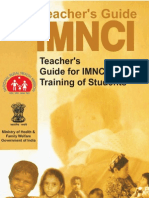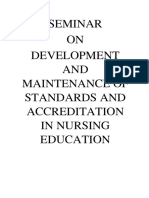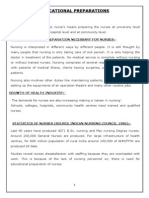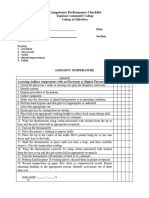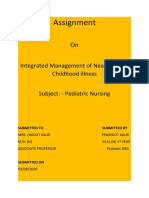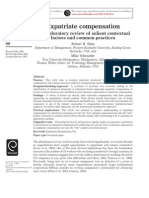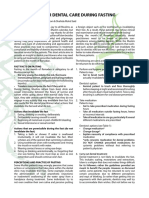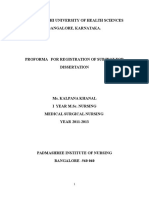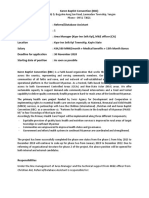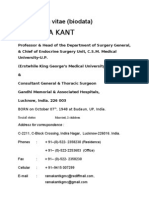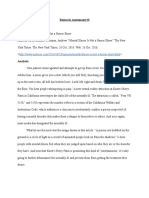Arjun Pts Orem - Sumitra Devi
Arjun Pts Orem - Sumitra Devi
Uploaded by
Chandan PradhanCopyright:
Available Formats
Arjun Pts Orem - Sumitra Devi
Arjun Pts Orem - Sumitra Devi
Uploaded by
Chandan PradhanOriginal Title
Copyright
Available Formats
Share this document
Did you find this document useful?
Is this content inappropriate?
Copyright:
Available Formats
Arjun Pts Orem - Sumitra Devi
Arjun Pts Orem - Sumitra Devi
Uploaded by
Chandan PradhanCopyright:
Available Formats
Application Of Orem's Self-Care Deficit theory In Nursing Practice
Submitted to: Mrs.Kamli prakash Vice principal (HCN)
Submitted by: Arjun kumawat m.sc.nursing1syr
Submitted on: 13/06/2011
PATIENT PROFILE Areas Name Age Sex Education Occupation Religion Diagnosis Patient details Mrs. Sumitra devi 56 years Female M.A. House wife Hindu DM with HTN with Cirrhosis of liver
Marital status Married
Theory applied Orems theory of self care deficit. For Mrs. Sumitra Devi She came to the hospital with complaints of high fever with chills and rigor. Patient suffering from vomiting and semiconscious. She developed these complaints suddenly and went to local hospital for treatment. There is no improvement in health and then she was adimtted in HIHT. DATA COLLECTION ACCORDING TO OREMS THEORY OF SELF CARE DEFICIT 1. BASIC CONDITIONING FACTORS Age Gender Health state Development state Sociocultural orientation Health care system Family system Patterns of living Environment resources 56 year Female High fever with chills and rigor. Patient suffering from vomiting & semiconscious.. Ego integrity vs despair M.A. Indian, Hindu Institutional health care Married, husband working in private job At home with partner Rural area, items for ADL in easy reach, no special precautions to prevent injuries Husband, daughter, son
2. UNIVERSAL SELF-CARE REQUISITES Breaths with difficulty & no pallor cyanosis Air Water Food Elimination Activity/ rest Social interaction Prevention of hazards Fluid intake is in sufficient. Edema is not present Turgor normal for the age Hb 10.6gm%, BMI = 14.Food intake is not adequate or the diet is not nutritious. Voids and eliminates bowel with urinary incontinence. Completely on bed since she is semiconscious Could not elicited, since she is semiconscious Need instruction to on care of body and prevention of falls. Need instruction to family on improvement of nutritional status. Promotion of normalcy Improving condition.
3. DEVELOPMENTAL SELF-CARE REQUISITES Maintenance of developmental environment Prevention/ management of the conditions threatening the normal development 4. HEALTH DEVIATION SELF CARE REQUISITES Adherence to medical regimen Family members report the problems to the physician when in the hospital. Cooperates with the medication, Not much aware about the use and side effects of medicines Awareness of potential problem associated with the regimen Family members are not aware about the actual disease process. Not compliant with the diet and prevention of hazards. Not aware about the side effects of the medications Modification of self image to incorporates changes in health status She maintains is self image. Could not elicited, since she is semiconscious Could not do, since she is semiconscious
Adjustment of lifestyle to accommodate changes in the health status and medical regimen.
Slowly improve his health.
5. MEDICAL PROBLEM AND PLAN Physicians perspective of the condition: Diagnosed Lt. Gaglionic bleed with post craniotomy and is on the following medications: s. no. Inj. Metrogyl 1. Inj. amikicin 1. Tab Diamox 2. Inj. Rantac Tab. 3. cefizan 4. Inj. prexarom 5. Inj. combitac 100ml 500mg 250mg 50mg 200mg 4ml 1.2 ml IV IV orally IV orally IV IV TDS BD TDS BD BD TDS OD Name of the drug dose rout frequency
Medical Diagnosis: DM with HTN with cirrhosis of liver. Medical Treatment: Medication and physical therapy. AREAS AND PRIORITY ACCORDING TO OREMS THEORY OF SELF-CARE DEFICIT: IMPORTANT FOR PRIORITIZING THE NURSING DIAGNOSIS. Air Water Food
Elimination Activity/ Rest Solitude/ Interaction Prevention of hazards Promotion of normalcy Maintain a developmental environment. Prevent or manage the developmental threats Maintenance of health status Awareness and management of the disease process. Adherence to the medical regimen Awareness of potential problem. modify self image Adjust life style to accommodate health status changes NURSING CARE PLAN ACCORDING TO OREMS THEORY OF SELF CARE APPLYING THE OREMS THEORY OF SELF-CARE DEFICIT, NURSING CARE PLAN FOR MRS. sumitra devi COULD BE PREPARED AS FOLLOWS A. THERAPEUTIC SELF CARE DEMAND: DEFICIENT AREA: FOOD ADEQUACY OF SELF CARE AGENCY: INADEQUATE NURSING DIAGNOSIS Inability to maintain the ideal nutrition related to inadequate intake and knowledge deficit OUTCOMES AND PLAN
a. Outcome: Improved nutrition b. Nursing Goals and objectives Goal: To achieve optimal levels of nutrition. Objectives: Mrs. Sumitra devi family memberswill: List the food items rich in iron, which are available in the locality. c. Design of the nursing system: Supportive, educative, d. Method of helping: guidance support Teaching IMPLEMENTATION Mutually planned and identified the objectives and the patient were made to understand about the required changes in the behavior to have the requisites met. EVALUATION Mrs. Sumitra family members understood the importance of maintaining an optimum nutrition. . The supportive educative system was useful for Mrs Sumitra ---------------------------------------------------------------B. THERAPEUTIC SELF CARE DEMAND: DEFICIENT AREA: NUTRITIONAL REQUIREMENT: INADEQUATE
NURSING DIAGNOSIS Inadequate nutrition less than body requirements related to semi consciousness and ryles tube feedings. OUTCOMES AND PLAN a. Outcome: improved nutritional status Maintain the ability to improve nutritional status. b. Nursing Goals and objectives Goal: To achieve optimal levels of nutritional status. Objectives: Mrs. Sumitra will: Able to maintain normal nutritional status. c. Design of the nursing system: Partly compensatory with family members d. Method of helping: 1. Guidance: Assess the various hindering factors for maintaining nutritional status and how to tackle them. 2. Support: Assess the nutritional status of the client. Maintain the intake and output chart
3. Teaching: Teach the family members the limitation in the intake of the patient has and the cooperation required
4. Promoting a developmental environment: Teach the family and help them to practice how to help the patient according to her needs IMPLEMENTATION Maintained regular diet. Included all fruit juices, dhal soups, milk etc. EVALUATION Client family members are comfortable and gained knowledge regarding nutritional status maintainence. The partly compensatory system was useful for Mrs. Sumitra ---------------------------------------------------------------------C. THERAPEUTIC SELF CARE DEMAND: DEFICIENT AREA: ACTIVITY ADEQUACY OF SELF CARE AGENCY: INADEQUATE NURSING DIAGNOSIS Self-care deficit: dressing, toileting related to restricted joint movement, secondary to the inflammatory process in the joints. OUTCOMES AND PLAN a. Outcome: improved self-care
b. Nursing Goals and objectives Goal: To achieve optimal levels of ability for self care. Objectives: Mrs. Sumitra will:
perform the dressing activities within limitations utilize the alternative measures available for improving the toileting c. Design of the nursing system: Partly compensatory with family members d. Method of helping: 1. Guidance: Assess the various hindering factors for self care and how to tackle them. 2. Support: Make the patient use commodes or stools to perform toileting and insist on avoidance of squatting position Provide assistance whenever needed for the self care activities Provide encouragement and positive reinforcement for minor improvement in the activity level. 3. Teaching: Teach the family members the limitation in the activity level the patient has and the cooperation required 4. Promoting a developmental environment: Teach the family and help them to practice how to help the patient according to her needs IMPLEMENTATION Mutually planned and identified the objectives and the patient were made to understand about the required changes in the behavior to have the requisites met. EVALUATION They performed the dressing activities with minimal assistance
Patient family members verbalized that They will perform the activities as instructed to get her ADL done. The partly compensatory system was useful for Mrs. Sumitra ---------------------------------------------------------------------D. THERAPEUTIC SELF CARE DEMAND: DEFICIENT AREA: PAIN CONTROL ADEQUACY OF SELF CARE AGENCY: INADEQUATE NURSING DIAGNOSIS Ineffective pain control related to lack of utilization of pain relief measures OUTCOMES AND PLAN a. Outcome: improved pain self control
b. Nursing Goals and objectives Goal: To achieve reduction in the pain. Objectives: Mrs. Sumitra will: describe the total plan of pharmacological and non pharmacological pain relief c. Design of the nursing system: supportive educative d. method of helping: Guidance: Explore the past experience of pain and methods used to manage them. . Support:
Provide rest to the joints and avoid excessive manipulations Provide hot and cold application to have better mobility. Encourage exercises to the joints by immersing in the warm water. Teaching: Teach the non pharmacological method to the patient once the pain is a little reduced.
IMPLEMENTATION Administer medications as prescribed by the physician Reduce unnecessary disturbance of the client. EVALUATION She demonstrated slight reduction in the pain behaviors. The supportive educative system was useful for Mrs. Sumitra -------------------------------------------------------------E. THERAPEUTIC SELF CARE DEMAND: DEFICIENT AREA: PREVENTION OF HAZARDS. ADEQUACY OF SELF CARE AGENCY: INADEQUATE NURSING DIAGNOSIS Potential for fall and fractures related to semiconscious. OUTCOMES AND PLAN a. Outcome: Absence of falls and injury to the patient b. Nursing Goals and objectives
Goal: prevent the falls and injury and to maintain a good health. Objectives: Mrs. Sumitra will: remain free from injury as evidenced by: c. Design of the nursing system: supportive, educative, promotive d. method of helping: Support Never leave the client alone in the unit Assess the patients gait, activities and the mental status for any confusion or irritability. Encourage the family members to use supportive devices as required. IMPLEMENTATION Accompanied the client all the time by nurse and family members. Assessed patient mental condition continuously for any signs of irritability. EVALUATION . Patient explained the various measures that they will take to prevent the injury. The supportive educative system was useful for Mrs. Sumitra ------------------------------------------------------------------
EVALUATION OF THE APPLICATION OF SELF CARE DEFICIT THEORY The theory of self-care deficit when applied could identify the self care requisites of Mrs. Sumitra from various aspects. This was helpful to provide care in a comprehensive manner. Patient family members were very cooperative
REFERENCES Alligood M R, TomeyA M. Nursing Theory: Utilization &Application .3rd ed. Missouri: Elsevier Mosby Publications; 2002. Tomey AM, Alligood. MR. Nursing theorists and their work. (5th ed.). Mosby, Philadelphia, 2002 George JB .Nursing Theories: The Base for Professional Nursing Practice .5th ed. New Jersey :Prentice Hall;2002.
You might also like
- CTD Module 1Document29 pagesCTD Module 1Raju Nalla0% (1)
- Continuing EducationDocument7 pagesContinuing EducationSwati SharmaNo ratings yet
- II MSC Medical Surgical Nursing, Urology and Renal NursingDocument1 pageII MSC Medical Surgical Nursing, Urology and Renal NursingBiju AntonyNo ratings yet
- OREM'SDocument32 pagesOREM'SJoji JohnNo ratings yet
- PhilosophyDocument3 pagesPhilosophymaakkanNo ratings yet
- Lower Limb: Clinicoanatomical ProblemDocument100 pagesLower Limb: Clinicoanatomical ProblemsrisakthiNo ratings yet
- CONFERENCEDocument11 pagesCONFERENCESanjeevNo ratings yet
- Independent Practice IssuesDocument40 pagesIndependent Practice IssuesHarish Kumar KumawatNo ratings yet
- Patient Care ConferenceDocument3 pagesPatient Care ConferenceValarmathiNo ratings yet
- QP 2012 Advanced Nursing PracticeDocument1 pageQP 2012 Advanced Nursing PracticeAxsa AlexNo ratings yet
- PEER GROUP TEACHING Independent PractionerDocument6 pagesPEER GROUP TEACHING Independent Practionerparushni dab100% (1)
- Presented by Babita Dhrue Ankita Panigrahi MSC Nursing Previous YearDocument15 pagesPresented by Babita Dhrue Ankita Panigrahi MSC Nursing Previous YearBabita DhruwNo ratings yet
- PROFESSIONAL Org-My SeminarDocument31 pagesPROFESSIONAL Org-My SeminarmariaNo ratings yet
- Educational Preparation: Jones Marina N.V Associate Professor Meenakshi College of NursingDocument63 pagesEducational Preparation: Jones Marina N.V Associate Professor Meenakshi College of NursingjonesmarinaNo ratings yet
- Innovative Approaches in Solving Nursing Services Problems - LatestDocument37 pagesInnovative Approaches in Solving Nursing Services Problems - Latestvallal0% (1)
- Document 1management of Nursing Educational InstitutionDocument13 pagesDocument 1management of Nursing Educational InstitutionHardeep Kaur100% (1)
- Preparation of Budget For A GNM School: IntroductionDocument12 pagesPreparation of Budget For A GNM School: Introductionsuchismita pandaNo ratings yet
- PDF Trends of Nursing Lesson PlanDocument15 pagesPDF Trends of Nursing Lesson PlanDiksha chaudharyNo ratings yet
- Nursing Research: Unit 1Document8 pagesNursing Research: Unit 1KiranNo ratings yet
- Development and Maintenance of Standards and Accreditation ofDocument6 pagesDevelopment and Maintenance of Standards and Accreditation ofsrimalathiNo ratings yet
- Assignment Development and Maintenance of Standards and Accreditation in Nursing Education ProgramsDocument10 pagesAssignment Development and Maintenance of Standards and Accreditation in Nursing Education ProgramsLavie GangwarNo ratings yet
- School Health ReportDocument5 pagesSchool Health Reportzinto vilaneNo ratings yet
- Teacher's Guide For IMNCI Training of Students-441Document121 pagesTeacher's Guide For IMNCI Training of Students-441National Child Health Resource Centre (NCHRC)No ratings yet
- Outcome Based Education WordDocument7 pagesOutcome Based Education Wordsp2056251No ratings yet
- Evaluation of Students Performance in Clinical Practice: Objective IDocument11 pagesEvaluation of Students Performance in Clinical Practice: Objective IAMY LALRINGHLUANI M.Sc. Child Health (Paediatric ) NursingNo ratings yet
- Seminar: Vandana Thakur M.Sc. Nursing 1 YearDocument73 pagesSeminar: Vandana Thakur M.Sc. Nursing 1 Yearabcqwe123No ratings yet
- Essentials of Nursing Educational InstitutionDocument11 pagesEssentials of Nursing Educational InstitutionLuke ShantiNo ratings yet
- Nicu ReportDocument20 pagesNicu ReportPithiya princiNo ratings yet
- "Documentation": Presented To: Madam Mrs. Avinash Rana Presented To: Mukta (m.sc.1 Yr)Document31 pages"Documentation": Presented To: Madam Mrs. Avinash Rana Presented To: Mukta (m.sc.1 Yr)gopscharanNo ratings yet
- Class Presentation ON Regulatory Bodies AND Professional OrganizationDocument14 pagesClass Presentation ON Regulatory Bodies AND Professional OrganizationDebashrita MisraNo ratings yet
- Cancer QuizDocument3 pagesCancer QuizOsama AtifNo ratings yet
- Public Relations M.SCDocument9 pagesPublic Relations M.SCDeepu VijayaBhanuNo ratings yet
- Preparation OF Group Work: Netaji Subhash College of NursingDocument7 pagesPreparation OF Group Work: Netaji Subhash College of NursingDimpal ChoudharyNo ratings yet
- Bed Side Teaching Whipple'S Procedure: Submitted To-Sarita Nadiya Madam Submitted By-Ms - ManishaDocument8 pagesBed Side Teaching Whipple'S Procedure: Submitted To-Sarita Nadiya Madam Submitted By-Ms - ManishaManisha Shakya100% (1)
- Futuristic NursingDocument3 pagesFuturistic NursingDeerpraj CmNo ratings yet
- Seminar EdDocument124 pagesSeminar EdDiksha chaudharyNo ratings yet
- Standards and Accreditation 2Document31 pagesStandards and Accreditation 2Delphy VargheseNo ratings yet
- Lesson Plan PositionDocument4 pagesLesson Plan PositionDeepika Patidar100% (1)
- Kauvery Hospital:: Kauvery Medical Centre-2002 - KMC Speciality Hospital Has Named As Kauvery Hospital. 2004Document21 pagesKauvery Hospital:: Kauvery Medical Centre-2002 - KMC Speciality Hospital Has Named As Kauvery Hospital. 2004Sashi Kumar0% (1)
- Preeti Jaiswal M.Sc. (N) 1 YRDocument38 pagesPreeti Jaiswal M.Sc. (N) 1 YRSeema YadavNo ratings yet
- Prasann & Group SymposiumDocument18 pagesPrasann & Group SymposiumPrasann RoyNo ratings yet
- Collaboration Issues and Models Within and Outside Nursing: Sangeetha Antoe M.SC (N)Document66 pagesCollaboration Issues and Models Within and Outside Nursing: Sangeetha Antoe M.SC (N)rinku100% (1)
- Professional Preparation and Training For CounselingDocument20 pagesProfessional Preparation and Training For Counselingnathsujitkr1980100% (1)
- Regulatory Bodies of Nursing in India: Dr. Maheswari JaikumarDocument75 pagesRegulatory Bodies of Nursing in India: Dr. Maheswari Jaikumarkalla sharonNo ratings yet
- 4304 - M.Sc. - Community - Health - Nursing ImportantDocument84 pages4304 - M.Sc. - Community - Health - Nursing ImportantpriyagerardNo ratings yet
- Annotated BibliographyDocument6 pagesAnnotated Bibliographyapi-268670617No ratings yet
- ASSIGNMENT ON Distance by KaminiDocument9 pagesASSIGNMENT ON Distance by Kaminikamini ChoudharyNo ratings yet
- Nightingale Institute of Nursing Noida: Seminar ON Code of Ethics Subject: Advance Nursing PracticeDocument11 pagesNightingale Institute of Nursing Noida: Seminar ON Code of Ethics Subject: Advance Nursing Practicesahib singhNo ratings yet
- Educational PreperationsDocument22 pagesEducational Preperationsjagraj147No ratings yet
- Checklist TempDocument1 pageChecklist TempHoneylouAzOpondaNo ratings yet
- B.SC Nursing Program: I. Overview of The ProgramDocument11 pagesB.SC Nursing Program: I. Overview of The ProgramTopeshwar TpkNo ratings yet
- A Study To Assess The Effectiveness of Video Assisted Teaching Programme On Toilet Training of Toddlers Among Parents in A Selected Rural Area at Mangalore, Dakshina Kannada, Karnataka StateDocument7 pagesA Study To Assess The Effectiveness of Video Assisted Teaching Programme On Toilet Training of Toddlers Among Parents in A Selected Rural Area at Mangalore, Dakshina Kannada, Karnataka StateInternational Journal of Innovative Science and Research TechnologyNo ratings yet
- Report On PanelDocument6 pagesReport On PanelBhawna PandhuNo ratings yet
- Assignment On Concept of Nursing EducationDocument6 pagesAssignment On Concept of Nursing Educationmaya verma100% (1)
- Clinical Rotation Plan FinalDocument3 pagesClinical Rotation Plan FinalShivani PatelNo ratings yet
- Gastritis-Lesson Plan by Abdul BasitDocument15 pagesGastritis-Lesson Plan by Abdul Basitbasithere6No ratings yet
- Critical Incident RecordDocument11 pagesCritical Incident RecordsuthaNo ratings yet
- Observation Visit To NSDocument12 pagesObservation Visit To NSpriyaNo ratings yet
- Assignment On IMNCIDocument3 pagesAssignment On IMNCIcharanjit kaurNo ratings yet
- Ventricular Septal Defect, A Simple Guide To The Condition, Treatment And Related ConditionsFrom EverandVentricular Septal Defect, A Simple Guide To The Condition, Treatment And Related ConditionsNo ratings yet
- Role of Dietary Fibers and Nutraceuticals in Preventing DiseasesFrom EverandRole of Dietary Fibers and Nutraceuticals in Preventing DiseasesRating: 5 out of 5 stars5/5 (1)
- A Case of Pica On A 6-Year-Old Child From MedanDocument3 pagesA Case of Pica On A 6-Year-Old Child From MedanatikahnurhNo ratings yet
- PDT SwanDocument8 pagesPDT Swanapi-293008848No ratings yet
- Exploring Workforce Confidence and Patient ExperiencesDocument10 pagesExploring Workforce Confidence and Patient Experiencesalumnospaul897No ratings yet
- Oncology NursingDocument8 pagesOncology NursingChelsea Aquino100% (2)
- Duterte Sona 2018Document25 pagesDuterte Sona 2018Leven Mart LacunaNo ratings yet
- Expatriate CompensationDocument11 pagesExpatriate Compensationcnu_neveb4No ratings yet
- Tips For Dental Care During Fasting PDFDocument2 pagesTips For Dental Care During Fasting PDFRafi Kusuma Ramdhan SukonoNo ratings yet
- 05 N293 33108Document23 pages05 N293 33108Arjay G ParaniNo ratings yet
- Mcqs in Pharmaceutical Calculations: Ryan F. Donnelly (Ed.) and Johanne Barry (Ed.)Document1 pageMcqs in Pharmaceutical Calculations: Ryan F. Donnelly (Ed.) and Johanne Barry (Ed.)sehrish jamilNo ratings yet
- Pharmacy Law Syllabus Fall 2017 FinalDocument7 pagesPharmacy Law Syllabus Fall 2017 FinalTiff VoNo ratings yet
- Sattva Dozee Impact-Assessment-Report July-2022Document31 pagesSattva Dozee Impact-Assessment-Report July-2022VIT NetflixNo ratings yet
- Food, Nutrition and HygieneDocument2 pagesFood, Nutrition and HygieneAmit TiwariNo ratings yet
- PSYC 1504 - Written Assignment Unit 7Document5 pagesPSYC 1504 - Written Assignment Unit 7Agastyasa GheaNo ratings yet
- Test Bank Theoretical Basis For Nursing 3rd Edition McewenDocument8 pagesTest Bank Theoretical Basis For Nursing 3rd Edition McewenAmber Oneill100% (29)
- Karen Baptist Convention (KBC) Is A Faith-Based Organization That Works Through 20 Associations AllDocument3 pagesKaren Baptist Convention (KBC) Is A Faith-Based Organization That Works Through 20 Associations AlllayhtawNo ratings yet
- The Effects of Interactive E-Learning On Delirium Recognition Ability and Delirium-Related Strain of Care Among Critical Care NursesDocument9 pagesThe Effects of Interactive E-Learning On Delirium Recognition Ability and Delirium-Related Strain of Care Among Critical Care NursesAz SalNo ratings yet
- Professor (DR) Rama Kant Biodata Curriculum VitaeDocument50 pagesProfessor (DR) Rama Kant Biodata Curriculum VitaebobbyramakantNo ratings yet
- Via Zis 1991Document2 pagesVia Zis 1991drvivek reddyNo ratings yet
- Ismresearchassessment 3Document8 pagesIsmresearchassessment 3api-339158068No ratings yet
- نظرية إليس في الارشادDocument3 pagesنظرية إليس في الارشادshreefnbeelNo ratings yet
- Mask Exemption Guideline - FormDocument2 pagesMask Exemption Guideline - FormMatt ThomasNo ratings yet
- Mental Disorders 1Document15 pagesMental Disorders 1api-509374276No ratings yet
- WHO CDS HIV 19.8 EngDocument24 pagesWHO CDS HIV 19.8 EngMaykel MontesNo ratings yet
- Facility ManualDocument124 pagesFacility ManualYulia Afrina NstNo ratings yet
- Irene Nthiwa NRS 493 RS1 IndividualSuccessPlan 01Document28 pagesIrene Nthiwa NRS 493 RS1 IndividualSuccessPlan 01Dallas CyberNo ratings yet
- CAPR Blueprint enDocument9 pagesCAPR Blueprint enramandeepkaurNo ratings yet
- NURS FPX 6025 Assessment 3 Practicum and Scholarly ArticleDocument4 pagesNURS FPX 6025 Assessment 3 Practicum and Scholarly Articlefarwaamjad771No ratings yet
- MTC 2015-4Document32 pagesMTC 2015-4davidescu5costinNo ratings yet
- Further - Hospital List - 022021 - Master - EngDocument5 pagesFurther - Hospital List - 022021 - Master - EngCarmen UngureanuNo ratings yet






















